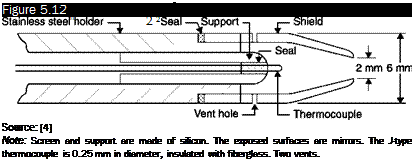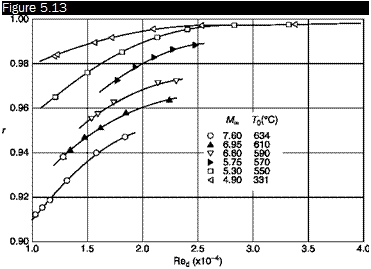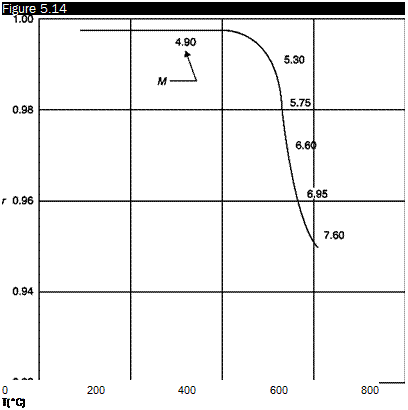Measurement of stagnation temperature
The importance of knowing the static temperature of the stream is obvious, considering that internal energy, conductivity, viscosity, specific heat, speed of sound all depend on temperature. Unfortunately, the measurement of static temperature is not possible in a compressible flow since whatever instrument is immersed in the stream, it is surrounded by a boundary layer in which the temperature rises above the stream temperature (remember that, vice versa, it is possible to measure the static pressure of the stream through a hole in the wall, see Chapter 2, since the static pressure remains unchanged in the boundary layer).
Excluding the possibility of making a thermometer run with the same speed of the stream, the static temperature can be determined only indirectly, once one has measured the stagnation temperature, by the equation
 |
Schematic of a probe for measuring the stagnation temperature
A probe consisting of a Pitot tube containing a thermocouple (Figure 5.12) and systems to minimize losses by conduction and radiation can be used to measure the stagnation temperature. Despite the best planning procedures, the probes will still read a temperature lower than stagnation temperature and, unfortunately, the correction varies appreciably with temperature, the Reynolds number and the Mach number.
Heat losses are in general: 80% by conduction and radiation from the shield, 15% by conduction from the base, 5% for conduction through the thermocouple wires, but they can change dramatically with changes in the design of the probe. The effectiveness of such a probe is usually defined on the basis of a recovery factor, r, given by:
![]() Tm – T T – T2
Tm – T T – T2
where Tm is the measured temperature. The following conditions will apply:
■ Shape of the probe: The chamber has an opening in the front for the thermocouple and ventilation holes immediately downstream of the thermocouple. The walls of the chamber are mirrors to reduce heat losses by radiation from the junction of the thermocouple.
■ Temperature sensor: Any thermocouple capable of withstanding the temperatures to be measured can be used. The junction should be far away from the support so as to leave a long section of the wires exposed to hot air to reduce losses by conduction. The heat capacity of
the junction should be as small as possible to reduce the response time of the probe.
■ Anti-radiation shield: An anti-radiation shield must surround the temperature sensor. The temperature of the shield is different from that of the sensor and therefore the temperature measured is influenced by heat transfer by radiation. To minimize this effect, the shield must have low conductivity, like the silicon shield in Figure 5.12, and the surface must be a mirror. The effectiveness of the shield can be enhanced by heating it or by using multiple shields (up to five).
■ Ventilation holes: As the air temperature in the stagnation chamber of the probe tends to decrease, due to conduction and radiation, it is necessary to provide vent holes to continuously replace the air in the chamber. When it is necessary to measure temperature fluctuations, the exchange of air helps in not damping fluctuations. The best ratio between area of the holes and entrance area of the probe, AV/A is a function of heat loss and should still be small so that air does not assume appreciable speed. Usually this ratio varies between 0.2 and 0.4.
■ Effects of Reynolds and Mach numbers: The presence of a normal shock wave at the entrance of the probe does not alter the value of the stagnation temperature. Obviously the performance of the probe deteriorates with increasing temperature (increasing losses due to all types of heat transfer): Figure 5.13 illustrates the typical decrease of
 |
Effects of Reynolds and Mach numbers on the recovery factor of a stagnation temperature probe
the recovery factor with decreasing Reynolds number and with increasing Mach number. Figure 5.14, derived from the data of Figure 5.13, shows the rapid decrease of the recovery factor that occurs when the Mach number exceeds the value 5. It can be concluded that in a supersonic wind tunnel (M < 5), a probe with a single shield has a recovery factor very close to 1 if the Reynolds number of the probe is greater than 20,000. For hypersonic wind tunnels (M > 5), probes can be made more accurate using small heating elements and thermocouples in the base of the probe, with additional heaters and thermocouples on the inner side of the shield. This will provide heating to balance the losses: in practice, the base is heated until it reaches the
 |
Probe for measuring the stagnation temperature: decrease of the recovery factor with temperature and Mach number
Source: [4]
Note: Red = 20,000. Probe with a single screen
same temperature as the main thermocouple and subsequently the shield is heated until its internal temperature is equal to that of the thermocouple. After another balancing all the temperatures are equal and the losses by conduction and radiation are zero (recovery factor equal to one).











